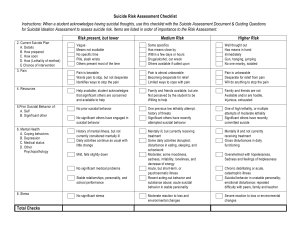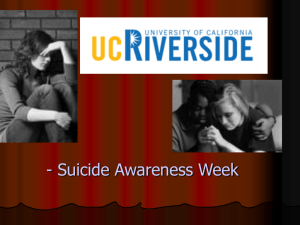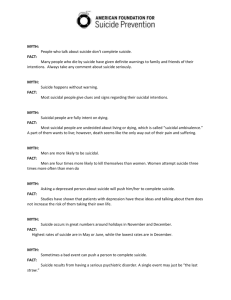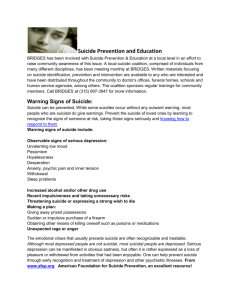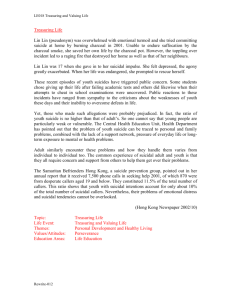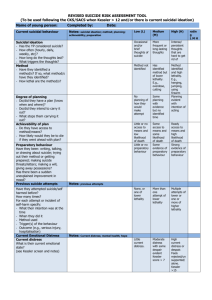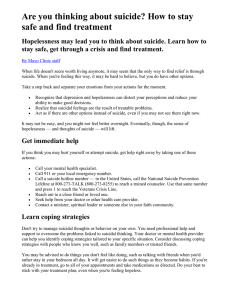Student Suicide Policy
advertisement
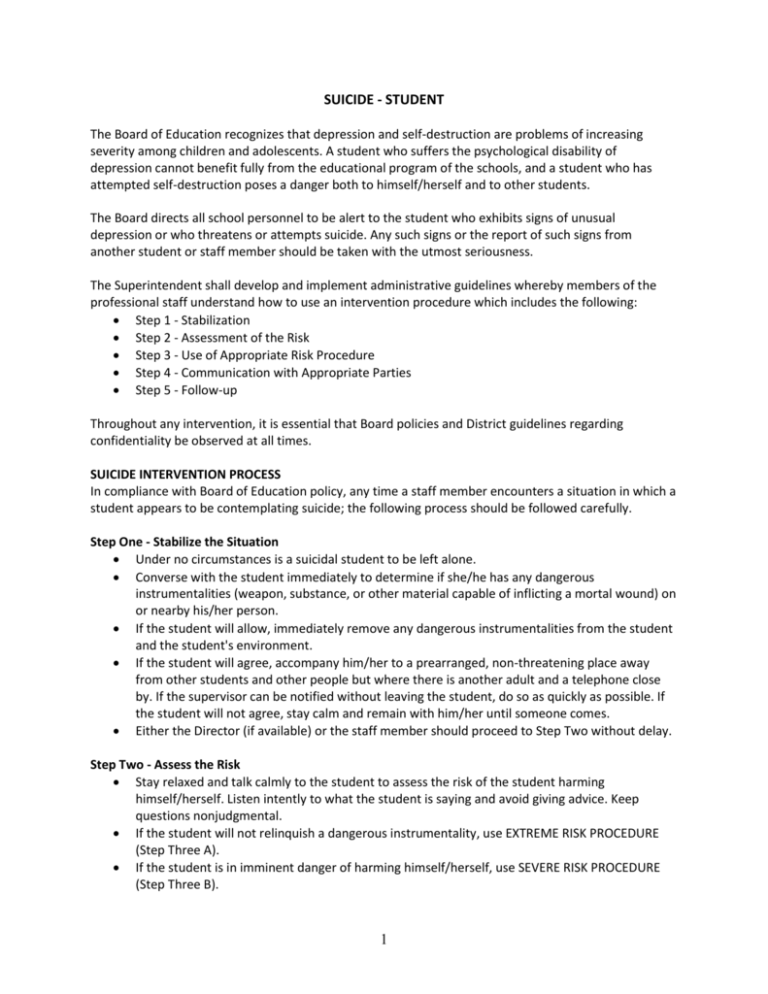
SUICIDE - STUDENT The Board of Education recognizes that depression and self-destruction are problems of increasing severity among children and adolescents. A student who suffers the psychological disability of depression cannot benefit fully from the educational program of the schools, and a student who has attempted self-destruction poses a danger both to himself/herself and to other students. The Board directs all school personnel to be alert to the student who exhibits signs of unusual depression or who threatens or attempts suicide. Any such signs or the report of such signs from another student or staff member should be taken with the utmost seriousness. The Superintendent shall develop and implement administrative guidelines whereby members of the professional staff understand how to use an intervention procedure which includes the following: Step 1 - Stabilization Step 2 - Assessment of the Risk Step 3 - Use of Appropriate Risk Procedure Step 4 - Communication with Appropriate Parties Step 5 - Follow-up Throughout any intervention, it is essential that Board policies and District guidelines regarding confidentiality be observed at all times. SUICIDE INTERVENTION PROCESS In compliance with Board of Education policy, any time a staff member encounters a situation in which a student appears to be contemplating suicide; the following process should be followed carefully. Step One - Stabilize the Situation Under no circumstances is a suicidal student to be left alone. Converse with the student immediately to determine if she/he has any dangerous instrumentalities (weapon, substance, or other material capable of inflicting a mortal wound) on or nearby his/her person. If the student will allow, immediately remove any dangerous instrumentalities from the student and the student's environment. If the student will agree, accompany him/her to a prearranged, non-threatening place away from other students and other people but where there is another adult and a telephone close by. If the supervisor can be notified without leaving the student, do so as quickly as possible. If the student will not agree, stay calm and remain with him/her until someone comes. Either the Director (if available) or the staff member should proceed to Step Two without delay. Step Two - Assess the Risk Stay relaxed and talk calmly to the student to assess the risk of the student harming himself/herself. Listen intently to what the student is saying and avoid giving advice. Keep questions nonjudgmental. If the student will not relinquish a dangerous instrumentality, use EXTREME RISK PROCEDURE (Step Three A). If the student is in imminent danger of harming himself/herself, use SEVERE RISK PROCEDURE (Step Three B). 1 If the student is not in imminent danger of harming himself/herself, use MODERATE RISK PROCEDURE (Step Three C). Step Three - Take Appropriate Action EXTREME RISK PROCEDURE Contact the police. Keep the student engaged in conversation as well as reassuring him/her until the police arrive. After the police arrive, and if good rapport has been established with the student, remain present to provide continuity and support as the police attempt to get the student to relinquish the dangerous instrumentality. Contact the student's parents and inform them of what has transpired and of the actions being taken. SEVERE RISK PROCEDURE Determine if the student's distress is the result of parental abuse, neglect, or exploitation. If so, notify Protective Services immediately, give them the facts, request them to intervene, and follow their instructions. If not, call the (Designated Health Care Facility) immediately, give them the facts, request them to intervene, and follow their instructions. If neither agency will intervene before the end of the school day, call the emergency squad. Make sure the student's parents have been contacted. MODERATE RISK PROCEDURE Try to determine the reason(s) for the student's distress. Contact the parents, give them the facts, and ask them to come to the school right away. Assist the parents in making contact with an agency or resource person who can provide appropriate intervention. Step Four - Communicate Inform the appropriate members of the District staff such as the school psychologist, the student's teachers, and/or school social worker of the facts and the actions being taken. Alert them that they need to observe the District's confidentiality requirements, although the occurrence was not something that developed during counseling. If the parents request, inform the student's close friends of the facts and the actions being taken. Step Five - Follow-Up Determine the extent to which emergency or short-term procedures were completed properly. Find out if arrangements have been made for long-term clinical and/or support services. If neither short-term procedures nor long-term services were properly conducted or pursued, consult with the Superintendent to determine appropriate action. Maintain continuing contact with the student to communicate interest in his/her welfare and support of the long-term services being provided. Remain alert to the possibility of "copy-cat" suicide attempts by other students. Evaluate Steps A - E. SUICIDE POSTVENTION PROCESS 2 If, in spite of all intervention efforts, a suicide should occur, implement the District's Crisis Intervention Plan. If additional guidance is needed, contact the American Association of Suicidology, 4201 Connecticut Avenue, Washington, D.C. 20008. (202) 237-2280. 3 SUICIDE REPORT FORM Student’s Name: ________________________________________ Date: ____________________ Name of Person Making Initial Report: ____________________________________________________ Name/Position of Person Handling Case: __________________________________________________ ___________________________________________________ Student Interview by: __________________________________________________________________ Comments: Parent/Responsible Person Contacted: ____________________________________________________ (Name) Parent Contact Made By: ________________________________ Date:_____________________ Parent Contact Witnessed By: ___________________________________________________________ Follow-up Taken: Follow-up Done By: ___________________________________________________________________ Comments: Other People/Organizations Contacted: This form is to be filed in the student’s confidential file separate from the student’s curriculum folder. 4 ASSESSMENT OF SUICIDE RISK Student Name ________________________________________ I.D.# __________ Date _______________ Counselor ____________________________ PROBABILITY OF ATTEMPT LOW______ MEDIUM ______ HIGH ______ Instructions: Use as a check list and average for final assessment. Each item carries the same weight. RISK Low Suicide Plan A. Details how B. Availability of means C. Time D. Lethality of method monoxide E. Chance of intervention Previous Suicide Attempts several moderate Medium High ____ Vague ____ some specifics ____ knows when, where, ____ ____ ____ not available, will have to get no specific time or in future pills, slash wrists ____ ____ ____ available, has close by within a few hours drugs & alcohol, car wreck, ____ ____ ____ has in hand immediately violent action, carbon ____ others present most of the time ____ others available if called upon ____ ____ none or one of low lethality several low or 1 medium lethality,____ 1 high lethality or ____ no one nearby; isolated history of repeated threats Stress pressure Symptoms A. Coping Behavior daily functioning ____ ____ no significant stress daily activities continue as ____ ____ with little change moderate reaction to loss, severe reaction to loss, pressure, or change or change some daily activities disrupted; ____ gross disturbances in disturbance in eating, sleeping, school work 5 ____ B. Depression hopelessness, ____ mild, feels slightly down ____ moderate, some moodiness, ____ sadness, irritability, loneliness and decrease of energy Resources available or are ____ help available; significant others____ family & friends available but concerned and willing to help unwilling to consistently help overwhelmed with sadness, feels worthless ____ family & friends not hostile, exhausted, injurious willing to help Type of Communication non-verbal expression ____ direct expression of feelings and____ suicidal intent interpersonalized suicidal goal ____ very indirect or (“They’ll be sorry – I’ll show of internalized suicidal them”) worthlessness) goal (guilt, Life Styles ____ behavior in unstable personality, stable relationships, personality, ____ recent, acting out behavior and ____ suicidal & school performance substance abuse; acute suicidal repeated difficulties behavior in stable personality teachers, etc. with peers, family, Medical Status or acute, ____ no significant medical problems ____ acute but short term or ____ psychosomatic illness TOTAL CHECKS ____ LOW ____ 6 MEDIUM chronically debilitated, catastrophic illness ____ HIGH
